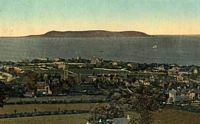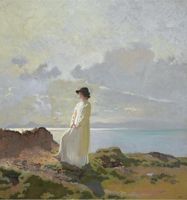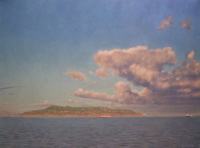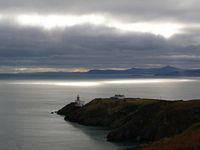Places – Dublin Bay
 Dublin Bay — bounded on the north by the headland of Howth, on the south by the Dalkey and Killiney hills, with the piers of Dún Laoghaire (then called Kingstown) harbour prominent on the southern shore.
Dublin Bay — bounded on the north by the headland of Howth, on the south by the Dalkey and Killiney hills, with the piers of Dún Laoghaire (then called Kingstown) harbour prominent on the southern shore. Sandycove Point, about a mile from the piers, marks the south-eastern tip of the Bay. The Bailey Lighthouse on Howth marks the north-eastern limit.
In the 19th century, Dublin Bay was notorious for shipwrecks. Frequent storms in the Irish Sea, silting from the River Liffey, sandbanks and rocky outcrops made the approach to Dublin hazardous. In consequence the Asylum Harbour in Kingstown (now Dún Laoghaire) was constructed in the 1830s.

"The southern margin of Dublin Bay has been more built over than the northern. ... Yet the beauty of the coastline is not spoilt, but rather enhanced, by the expansion of the city. The houses are not crowded, there is ample room for garden, shrubbery, park and pleasure-ground. Ever and anon the foliage parts or the villas stand away for a moment so as to give glimpses of the sea below, in summer a broad expanse of blue, flecked with white sails, and placid as an inland lake." — D. A. Chart, The Story of Dublin, 1907.
The Bay traces the Dublin arc of Joyce's Ulysses: the novel opens at the Forty Foot at the south, where Buck Mulligan takes his dip in the "snot-green" sea; and closes at Howth in the north, where, in the remembrance of Molly, Bloom made love to her ... "among the rhododendrons".
Wikipedia: Dublin Bay Howth — the headland of Howth which forms the northern bound of the crescent of Dublin Bay, joined to Dublin by the tombolo at Sutton. It's pronounced to rhyme with "both".
Howth — the headland of Howth which forms the northern bound of the crescent of Dublin Bay, joined to Dublin by the tombolo at Sutton. It's pronounced to rhyme with "both". "An ideal way of spending a fine summer day is offered by an excursion to Howth, which is distant about nine miles from the city ... Howth may be reached by electric car, fare 5d. each way. The journey is a delightful and refreshing one, especially in the summer and autumn months, and if an outside seat can be obtained." — Tours of Dublin, 1905.
"An ideal way of spending a fine summer day is offered by an excursion to Howth, which is distant about nine miles from the city ... Howth may be reached by electric car, fare 5d. each way. The journey is a delightful and refreshing one, especially in the summer and autumn months, and if an outside seat can be obtained." — Tours of Dublin, 1905.Wikipedia: Howth
Howth in old postcards
